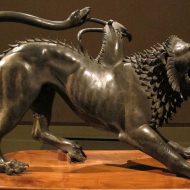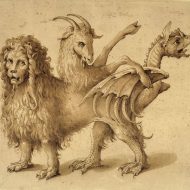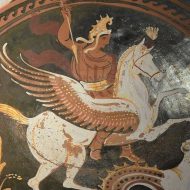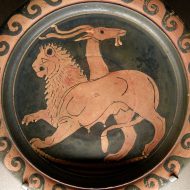Chimera : The 3 headed Beast
Listen
At a glance
| Description | |
|---|---|
| Origin | Greek Mythology |
| Classification | Hybrids |
| Family Members | Typhoeus (Father), Echidna (Mother), Cerberus and Lernaean Hydra (Siblings) |
| Region | Greece |
| Associated With | 3 heads, Hell, Evil |
Chimera
Introduction
In Greek mythology, the creature known as the chimera is a fire-breathing female monster that attacked Lycia and Caria. It was later killed by Bellerophon. Some western scholars of Chinese art, starting with Victor Segalen, use the word “chimera” generically to refer to winged leonine or mixed species quadrupeds, such as Bixie, Tianlu, Ky Lan and even Qilin.
Physical Traits
The most common description of the chimera comes from Homer’s Illiad, in which the creature is said to have the head of a lion, the body of a goat, and tail of a snake. Despite being classified as a female, the lion’s head has a mane which is typical of male lions.
Family
The Chimera’s origins are highly disputed and its genealogy has never been formally agreed upon. According to Hesiod, the Chimera’s mother was a certain ambiguous “she”, which may refer to Echidna, in which case the father would presumably be Typhon, though possibly the Hydra or even Ceto was meant instead.
Other accounts say that Chimera was the child of Typhoeus and Echidna and sibling of Cerberus and the Lernaean Hydra. There are several different genealogies—in one version, it mated with its brother, Orthrus, and mothered the Sphinx and the Nemean Lion.
Powers and Abilities
It is believed that the Chimera can breath fire and was said to be incredibly powerful as it had abilities of all three creatures rolled into one.
Modern Day Influence
The concept of the chimera is commonly associated with ancient art, and it is also used in pop culture. In terms of pop culture, it refers to any creation that is a hybrid or a single entity composed of two or more distinct entities. It is often used in television shows and role-playing games, usually as an obstacle for players to overcome.
The concept of the chimera is that it represents the most dangerous creature that humans can imagine. Its role is to challenge heroes to use their bravery and strength in order to win.
The concept of the chimera has been used in various pop culture mediums, such as video games and role-playing games as the Dungeons and Dragons series, as well as the popular video-game series Final Fantasy. In some of the most popular science fiction films, such as Star Wars, Star Trek, and The X-Files, the creature has been used to describe the creations of genetically engineered hybrids.
Related Images
Frequently Asked Questions
What does chimera mean?
In Greek mythology, a chimera was a monstrous fire-breathing hybrid, typically depicted with the head and body of a lion, a goat emerging from its back, and a venomous snake for a tail. This fearsome creature embodied chaos and the untamed wild, breathing fire and wreaking havoc.
What kind of monster is a chimera?
Imagine a lion roaring, a goat charging, and a viper hissing, all fused into one fire-breathing beast: that’s the chimera, a monstrous hybrid symbolizing chaos and untamed wilderness, its every part a terrifying blend of power and unpredictability.
Who killed chimera?
Bellerophon, astride the mighty Pegasus, soared above the fire-breathing Chimera, raining arrows into its vulnerable throat until the monstrous hybrid finally fell, proving that even against unimaginable terror, cunning and courage can prevail.
What is the myth of the Chimera?
Born of chaos, the Chimera terrorized Lycia with lion’s roar, goat’s fury, and serpent’s venom. But Bellerophon, riding the celestial Pegasus, danced above the flames, his arrows finding not fire, but death in the serpent’s neck. Thus fell the impossible beast, a testament to the hero’s cunning and the triumph over even the darkest fears.
What does Chimera symbolize?
The Chimera roars with untamed chaos, hissing fear of the unknown, yet whispers hope of triumph over adversity. It weaves nature’s discord and ignites creative fire, a monstrous tapestry reflecting the depths of our fears and the heights of our imagination.











